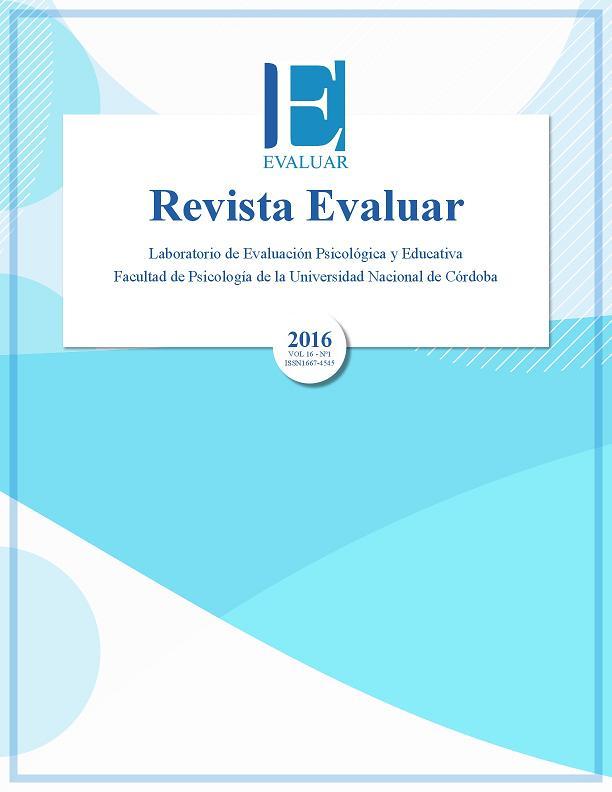Validation of the job performance scale in argentinean workers.
DOI:
https://doi.org/10.35670/1667-4545.v16.n1.15714Keywords:
Job Performance, Psychometric Properties, Internal Structure EvidenceAbstract
The aim of this study was to validate and analyze psychometric properties of Koopmans et al. (2013) Individual Work Performance Scale. A pilot study with 31 postgraduate students was performed to assay the operational equivalence of the scale. A main study was carried out, in order to analyze the psychometric properties of the scale adapted in the pilot study. This time, the non-probabilistic sample comprised 434 workers. Factor analyses (exploratory and confirmatory) were executed over the data obtained. Both of them indicated a trifactorial structure with adequate internal consistency (task performance: ? = .76, counterproductive behaviors: ? = .76, and contextual performance: ? = .72), composite reliability (CR greater than .70), and convergent validity (AVE greater than .50). Argentinean version of the instrument was conformed by 13 items and proved to be a reliable and parsimonious scale to measure perceived job performance.Downloads
References
Aarabi, M. S., Subramaniam, I. D., Almintisir, A. B., & Akeel, A. B. (2013). Relationship between motivational factors and job performance of employees in malaysian service industry. Asian Social Science, 9(9), 301-310. doi: 10.5539/ass.v9n9p301
Aguinis, H., & Edwards, J. (2014). Methodological wishes for the next decade and how to make wishes come true. Journal of Management Studies, 51(1), 143-174. doi: 10.1111/joms.12058
Aguinis, H., Joo, H., & Gottfredson, R. K. (2011). Why we hate performance management - And why we should love it. Business Horizons, 54(6), 503-507. doi: 10.1016/j.bushor.2011.06.001
American Psychological Association. (2010). Publication manual of the American Psychological Association (6ª ed.). Washington, DC: American Psychological Association.
Ato, M., López, J. J., & Benavente, A. (2013). Un sistema de clasificación de los diseños de investigación en psicología. Anales de Psicología, 29(3), 1038-1059. doi: 10.6018/analesps.29.3.178511
Baglin, J. (2014). Improving your exploratory factor analysis for ordinal data: A demonstration using FACTOR. Practical Assessment, Research & Evaluation, 19(5), 2-15. Recuperado de http://pareonline.net/getvn.asp?v=19&n=5
Bagozzi, R., & Yi, Y. (2012). Specification, evaluation, and interpretation of structural equation models. Journal of the Academy of Marketing Science, 40(1), 8-34. doi: 10.1007/s11747-011-0278-x
Bentler, P. (2006). EQS 6 Structural Equations Program Manual. Encino, CA: Multivariate Software.
Chiang, C., & Hsieh, T. (2012). The impacts of perceived organizational support and psychological empowerment on job performance: The mediating effects of organizational citizenship behavior. International Journal of Hospitality Management, 31(1), 180-190. doi: 10.1016/j.ijhm.2011.04.011
Consejo Nacional de Investigaciones Científicas y Técnicas, Comité de ética (2006). Lineamientos para el comportamiento ético en las Ciencias Sociales y Humanidades (Resolución No. 2857). Buenos Aires: Consejo Nacional de Investigaciones Científicas y Técnicas (CONICET).
Dalal, R. S., Baysinger, M., Brummel, B. J., & LeBreton, J. M. (2012). The relative importance of employee engagement, other job attitudes, and trait affect as predictors of job performance. Journal of Applied Social Psychology, 42(1), 295-325. doi: 10.1111/j.1559-1816.2012.01017.x
Díaz-Cabrera, D., Hernández-Fernaud, E., Isla-Díaz, R., Delgado-Rodríguez, N., Díaz-Vilela, L., & Rosales-Sánchez, C. (2014). Factores relevantes para aumentar la precisión, la viabilidad y el éxito de los sistemas de evaluación del desempeño laboral. Papeles del Psicólogo, 35(2), 115-121. Recuperado de http://www.redalyc.org/pdf/778/77831095004.pdf
Fornell, C., & Larcker, D. F. (1981). Evaluating structural equations models with unobservable variables and measurement error. Journal of Marketing Research, 18(1), 39-50. doi: 10.2307/3151312
Gadermann, A. M., Guhn, M., & Zumbo, D. (2012). Estimating ordinal reliability for Likert-tipe and ordinal item response data: A conceptual, empirical, and practical guide. Practical Assessment, Research & Evaluation, 17(3), 1-13. Recuperado de http://pareonline.net/pdf/v17n3.pdf
Gruman, J. A., & Saks, A. M. (2011). Performance management and employee engagement. Human Resource Management Review, 21(2), 123-136. doi: 10.1016/j.hrmr.2010.09.004
Hair, J. E., Black, W. C., Babin, B. J., Anderson, R. E., & Tatham R. L. (2010). Multivariate Data Analysis (6ª ed.). Upper Saddle River, NJ: Pearson-Prentice Hall.
Henseler, J., Ringle, C. M., & Sarstedt, M. (2015). A new criterion for assessing discriminant validity in variance-based structural equation modelling. Journal of the Academy of Marketing Science, 43(1), 115-135. doi: 10.1007/s11747-014-0403-8
Hoffmann, A., Stover, J., de la Iglesia, G., & Fernández-Liporace, M. (2013). Correlaciones policóricas y tetracóricas en estudios factoriales exploratorios y confirmatorios. Ciencias Psicológicas, 7(2), 151-164. Recuperado de http://www.scielo.edu.uy/scielo.php?script=sci_arttext&pid=S1688-42212013000200005
Kline, R. B. (2011). Principles and practice of structural equation modeling (3ª ed.). New York, NY: Guilford.
Koopmans, L., Bernaards, C. M., Hildebrandt, V. H., Van Buuren, S., Van der Beek, A. J., & De Vet, H. C. (2013). Development of an individual work performance questionnaire. International Journal of Productivity and Performance Management, 62(1), 6-28. doi: 10.1108/17410401311285273
Koopmans, L., Bernaards, C. M., Hildebrandt, V. H., De Vet, H. C., & Van der Beek, A. J. (2014). Measuring individual work performance: Identifying and selecting indicators. Work, 48(2), 229-238.
Koopmans, L., Bernaards, C. M., Hildebrandt, V. H., Lerner, D., De Vet, H. C., & Van der Beek, A. J. (2016). Cross-cultural adaptation of the Individual Work Performance Questionnaire. Work, 53(3), 609-619.
LePine, J. A., Erez, A., & Johnson, D. E. (2002). The nature and dimensionality of organizational citizenship behavior: A critical review and meta-analysis. Journal of Applied Psychology, 87(1), 52-65. doi: 10.1037/0021-9010.87.1.52
Lloret-Segura, S., Ferreres, A., Hernández, A., & Tomás, I. (2014). El análisis factorial exploratorio de los ítems: Una guía práctica, revisada y actualizada. Anales de Psicología, 30(3), 1151-1169. doi: 10.6018/analesps.30.3.199361
Lorenzo-Seva, U., & Ferrando, P. J. (2013). FACTOR 9.2: A comprehensive program for fitting exploratory and semiconfirmatory factor analysis and IRT models. Applied Psychological Measurement, 37(6), 497-498. doi: 10.1177/0146621613487794
Muñiz, J., Elosua, P., & Hambleton, R. (2013). Directrices para la traducción y adaptación de los tests: Segunda edición. Psicothema, 25, 151-157. Recuperado de http://www.psicothema.com
Murphy, K. R. (1990). Job performance and productivity. En K. R. Murphy & F. E. Saal (Eds). Psychology in Organizations: Integrating science and practice (pp. 157-176). Hillsadle, NJ: Erlbaum.
O’Boyle, E. H., Humphrey, R. H., Pollack, J. M., Hawver, T. H., & Story, P. A. (2011/2010). The relation between emotional intelligence and job performance: A meta?analysis. Journal of Organizational Behavior, 32(5), 788-818. doi: 10.1002/job.714
Pablos-Teijeiro, J. M., & Biedma-Ferrer, J. M. (2013). La evaluación del rendimiento individual. Un instrumento válido para lograr la eficiencia en la gestión de recursos humanos en las administraciones públicas. Gestión y Análisis de Políticas Públicas, 10, 1-18. doi: 10.24965/gapp.v0i10.10115
Rich, B. L., LePine, J. A., & Crawford, E. R. (2010). Job engagement: Antecedents and effects on job performance. Academy of Management Journal, 53(3), 617-635. doi: 10.5465/amj.2010.51468988
Robbins, S., & Judge, T. (2009). Comportamiento organizacional (13ª ed.). México, DF: Pearson Educación.
Satorra, A. (2002). Asymptotic robustness in multiple group linear-latent variable models. Econometric Theory, 18(2), 297-312. doi: 10.1017.S0266466602182041
Schoorman, D. F. & Mayer, R. C. (2008). The value of common perspectives in self-reported appraisals: You get what you ask for. Organizational Research Methods, 11, 148-159. doi: 10.1177/1094428107307168
Downloads
Published
How to Cite
Issue
Section
License
Copyright (c) 2016 Sebastián Gabini, Solana Salessi

This work is licensed under a Creative Commons Attribution 4.0 International License.
Revista Evaluar aplica la Licencia Internacional de Atribuciones Comunes Creativas (Creative Commons Attribution License, CCAL). Bajo esta licencia, los autores retienen la propiedad de copyright de los artículos pero permiten que, sin que medie permiso de autor o editor, cualquier persona descargue y distribuya los artículos publicados en Evaluar. La única condición es que siempre y en todos los casos se cite a los autores y a la fuente original de publicación (i.e. Evaluar). El envío de artículos a Evaluar y la lectura de los mismos es totalmente gratuito.




_(3).jpg)



.jpg)



